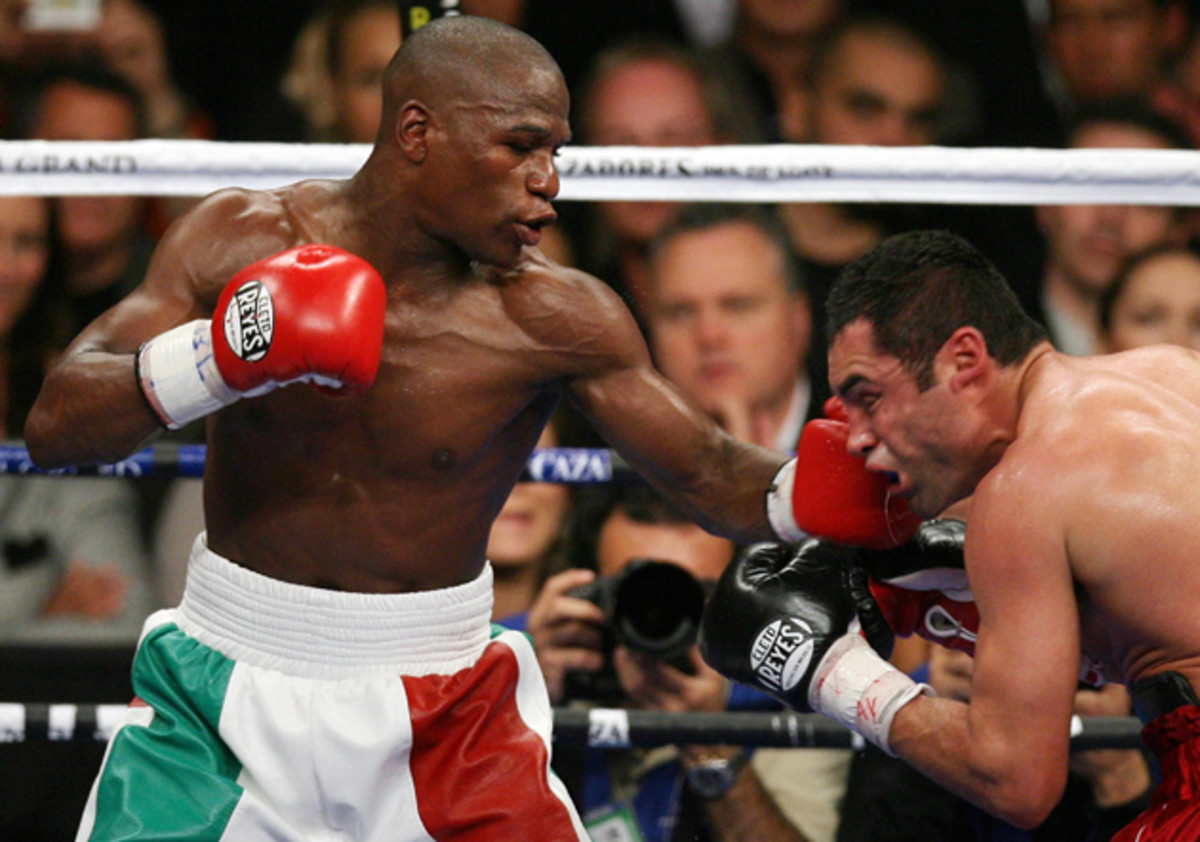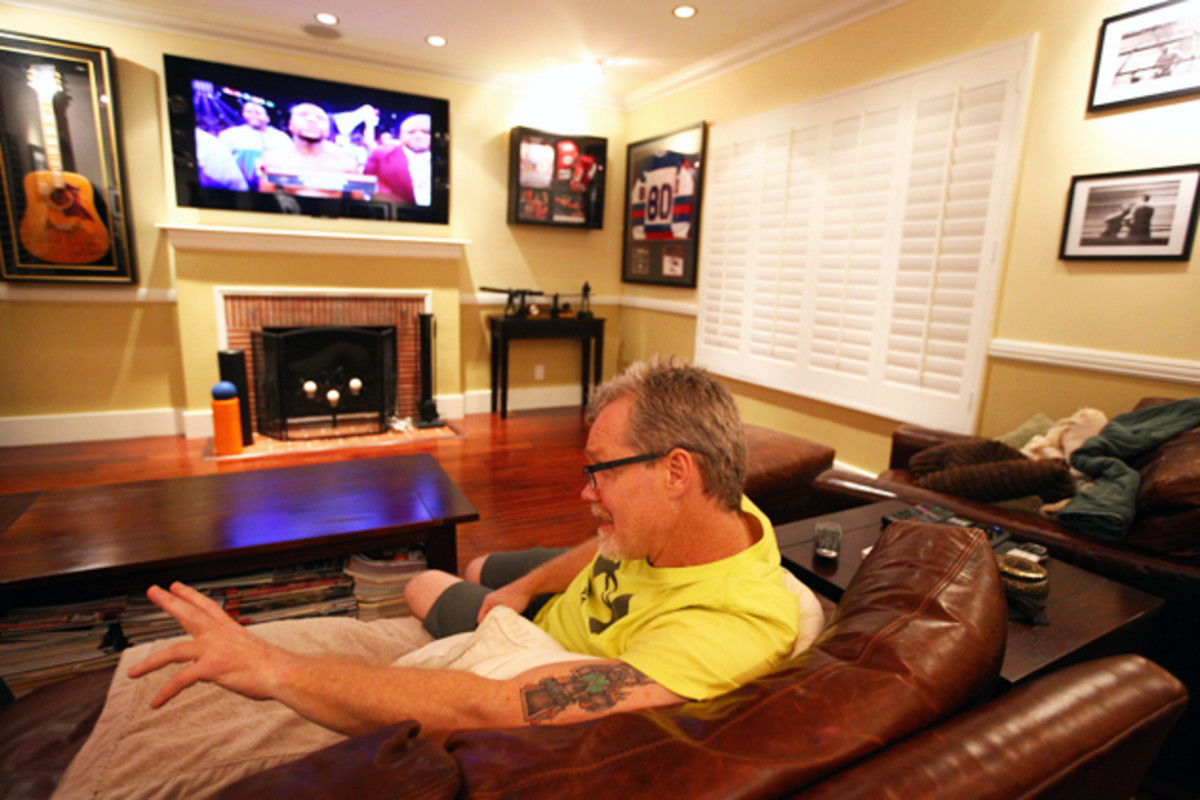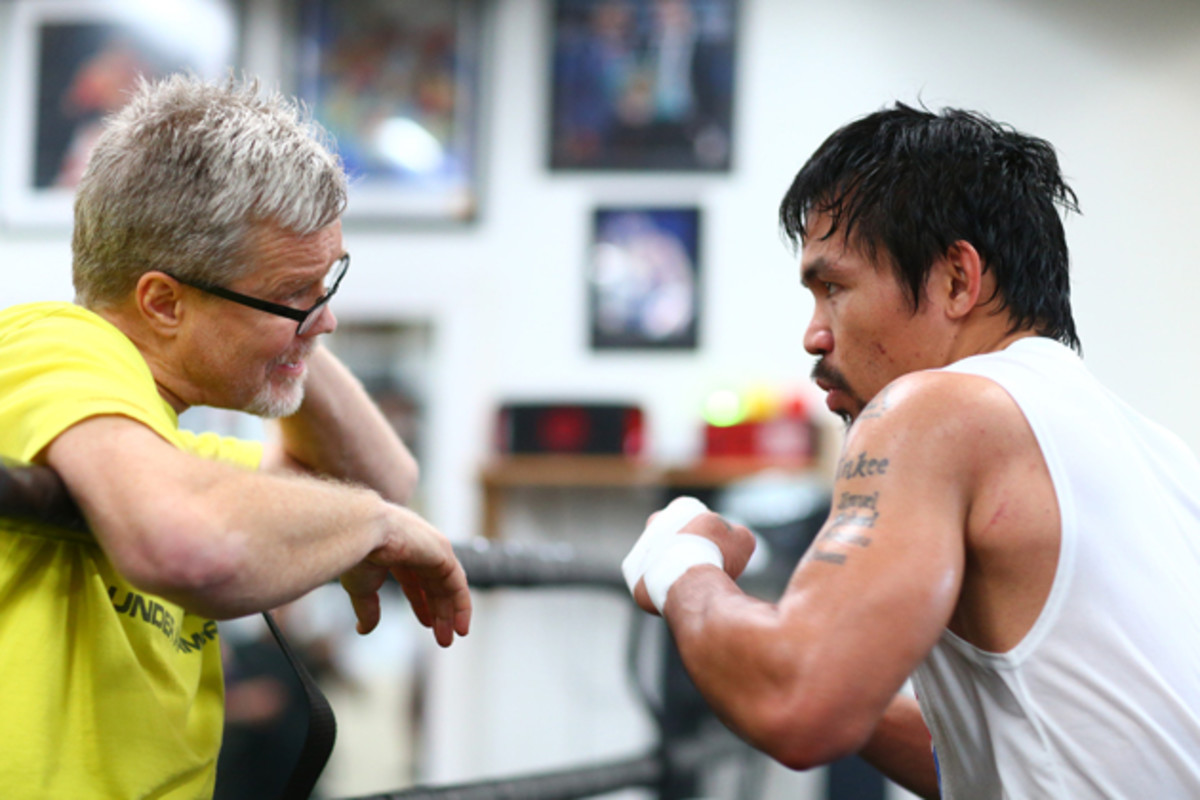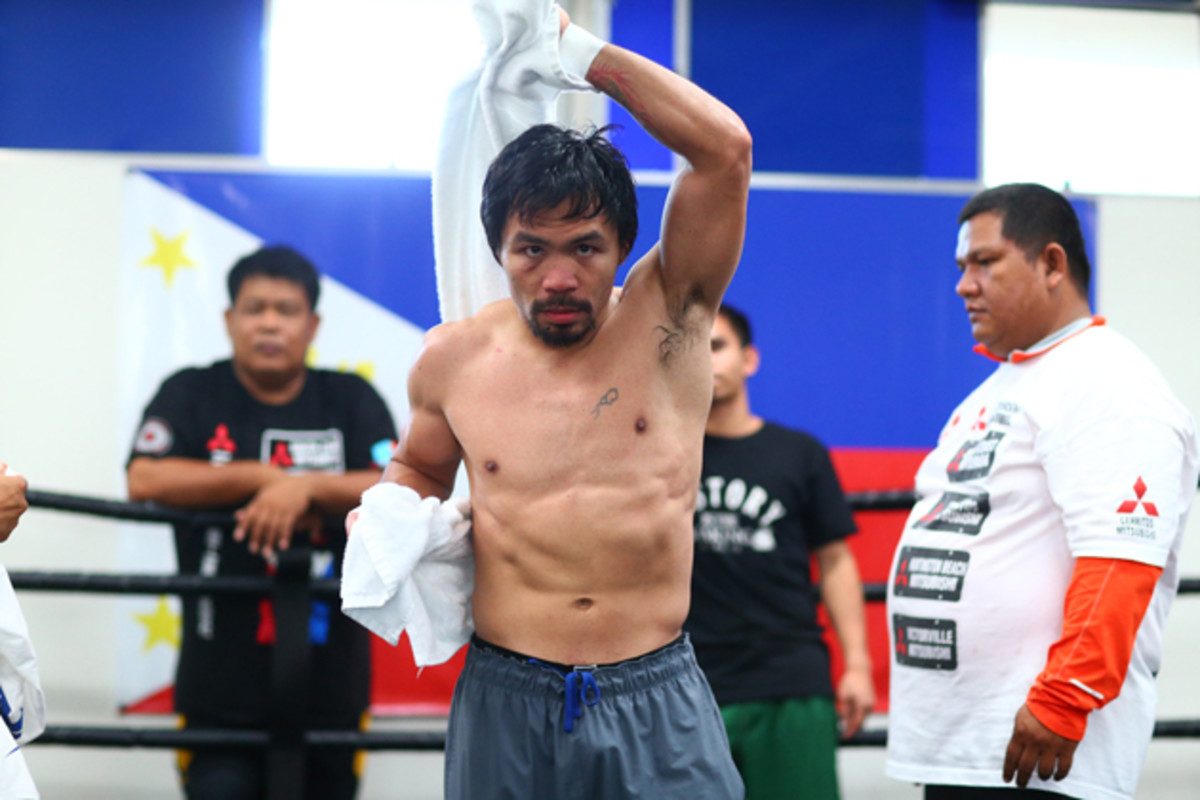Pacquiao's trainer looks back to find blueprint for beating Mayweather

HOLLYWOOD, Calif. – Freddie Roach reclines on the black leather couch in his living room, near the guitar signed by John Mellencamp, the framed picture of Rocky Marciano, the samurai sword, the boomerang and the jersey signed by every member of the 1980 U.S. men’s hockey team.
There’s a book on his shelf that seems appropriate, especially after his prized pupil, Manny Pacquiao, finally agreed to terms with Floyd Mayweather Jr. They will hold the Fight of the Century on May 2. The book’s title is Getting to Yes: Negotiating Agreement Without Giving In. But Roach, Pacquiao’s trainer, swears he has yet to read it.
• BISHOP: Pacquiao-Mayweather is the only treatment for Roach's pain
The last Fight of the Century took place exactly eight years before this Fight of the Century. Roach was there. It was the only time he trained Oscar De La Hoya.
Mayweather was there, too, opposite De La Hoya in the ring. That bout ranks among the closest of his 47 victories, one that he escaped with a split decision. Mayweather looks at that fight as the night that launched him toward superstardom, the bout in which he introduced “Money Mayweather” to the world in a heel turn that banked him hundreds of millions and made him a force among the most divisive in sports.

Roach, 55, looks at that fight and sees something else. He sees a blueprint for Pacquiao to beat Mayweather, the same way De La Hoya almost did.
(But first, Roach’s mother summons him to dinner. She lives next door. On his way out of the living room, Roach shares a quick anecdote. His mother used to make the shorts he boxed in. “But in the middle of the fights, sometimes the ass would tear out, and then everyone is laughing at you,” he says. He shakes his head. Then he heads over for spaghetti and meatballs.)
After dinner, he settles back into the couch. He’s mic’d up by a documentary crew. It’s apparent then that Roach is like most people in the world, in that he has about six remotes and only a vague idea of how to operate the system. “You know how to work this thing?” he asks.
He talks while various visitors try to work the remote control. “Floyd’s boring,” he says. “I’ve been to a couple of his fights live, and they were absolutely terrible. Somebody told me he knocked out Zab Judah today. Who cares? Zab Judah’s older than me.”
Roach had dinner with another of his boxers, Miguel Cotto, a few days earlier. Cotto is among the handful of fighters who have faced both Mayweather and Pacquiao. He told Roach that if they had trained together for that fight he would have beaten Mayweather. He didn’t seem all that impressed. We’ll never know. They didn’t train together. He didn’t win.

Nobody can figure out the remote, so we call up the Mayweather-De La Hoya fight on YouTube on my laptop. Roach’s wireless network is listed under “Keep Punching.” It takes three text messages to ascertain the passcode.
Mayweather-Pacquiao, he says, will be decided by footwork and movement, the dance between elite athletes before they throw a punch. It’s less about blows landed and more about how those blows are set up. “There is a science to fighting southpaws and righties,” Roach says. “It’s very important. Especially the footwork.”
****
When Roach and De La Hoya started to train for Mayweather, Roach came upon a shocking revelation. De La Hoya, then 42 fights into his professional career and one of the best boxers in the world, did not know how to properly cut off the ring. He told Roach that no one had ever taught him. Roach thought he was “f------- with me,” but it turns out that De La Hoya was not only serious but also correct. “This is something I learned at six,” Roach says.
SI Vault: Mayweather's record-breaking 2007 fight vs. De La Hoya
The initial rounds play on the laptop, and De La Hoya is able to cut the ring off against Mayweather, to force him back into corners, against the ropes, where he lands jabs in flurries. “For the first six rounds, he was perfect,” Roach says.
But Mayweather is unlike most boxers, Roach says, in that he likes to operate near the ropes. Most get caught there and scramble to get away. Mayweather is comfortable there. That’s his office.
Mayweather is the best technical boxer of his generation, a defensive wizard who rarely steps out of position. There’s a reason he competed on Dancing with the Stars. Moving backward affords him a bit more room to work. But it’s more than that, Roach says. When Mayweather moves backward, he does so in a deliberate way, so that the most obvious choice for his opponent is to follow him back, their bodies aligned straight on. His goal there is to evade any attack and then counter. It’s the angle that sets the counter up.

Roach’s strategy includes two key points for Pacquiao in that regard. 1) He must move Mayweather backward, but not follow him. “If you jab or feint him, and he steps back, you have a huge advantage to score,” Roach says. “But you have to score, and you have to get out really quickly. Mayweather will throw back. But he won’t counter until you stop. Some fighters will just keep throwing at him. My fighter shouldn’t. In and out. Clean combinations.” And 2) if Mayweather does move backward, what Roach calls setting a trap, Pacquiao must not approach him straight on.
Roach wants Pacquiao to set up combinations with his jab, which Roach thinks is better than De La Hoya’s jab. That, he says, is his favorite punch for Pacquiao to throw. But it’s not Pacquiao’s favorite. He can be lazy with the jab.
• BISHOP: Roach explains his strategy, bond with Pacquiao after 14 years
On the laptop, De La Hoya continues to pound Mayweather with shots to the head. Roach says he may use a sparring partner as a “confidence booster” for Pacquiao, and he means he may put someone in with Pacquiao in the expectation that partner will get knocked out. “Manny is faster than Oscar,” he says. “He sets up a lot better. Oscar doesn’t feint. He’s not jabbing enough. He’s not going to the body.”
Roach sees himself on the laptop between rounds, his hair cut unusually short. Camp had been in Puerto Rico. He says they offered two kinds of haircuts at that barbershop, No. 1 or No. 2, the shortest cuts available. This is before Round 7, and De La Hoya looks worried, even though he is at that point clearly ahead. Roach was already concerned. “Because it’s very, very hard to trust somebody when it’s your first fight together,” he says. “If it was our second, maybe there’s a whole different story.”
****
The bell rings for Round 7, and Mayweather assumes the defensive posture he made famous, the shoulder roll. He is leaned back, but slightly, his left shoulder tilted up like a shield. That’s a defense that Roach believes Pacquiao can penetrate. Because a southpaw, if he gets close enough, can tag Mayweather in that left shoulder with a straight left, or a series of them. The angle is better. Theoretically, anyway. “He’s rolling right into a southpaw’s power,” Roach says. “That’s a huge advantage for us.”
Enter the Cryosauna, the new-age training device of Floyd Mayweather
Pacquiao is the best offensive fighter of his generation, and his movement is scattered and unorthodox. That in theory could allow him to penetrate Mayweather’s impenetrable defense. When Roach first trained Pacquiao, he moved in and out. They added side-to-side movement next. Then they put both together. “We finally got to where it was perfect,” he says. “See, Oscar is pursuing him there.” De La Hoya lands a right to the body and slithers back away. “Manny has to do that.”
As Roach watches, he remembers what it felt like, as a fight that seemed won started to slip away. “See, Oscar followed him right into that shot,” Roach says. I ask if Pacquiao’s aggressiveness could hurt him the same way, as it did when Juan Manuel Marquez knocked Pacquiao out cold. Roach nods. That’s part of what they’re working on.
Roach stands up in the living room to demonstrate. It’s all about the footwork, he says. He tells me to step backward. I do. Then he lands an open-hand straight left to the chest that momentarily takes my breath away. He didn’t mean to hit me. (I think.) My photographer cackles in the background. (Thanks.)
• MANNIX: Mayweather a big challenge for Freddie Roach
He continues the demonstration. When Mayweather steps backward, Roach does not want Pacquiao to follow him. He wants Pacquiao to move to his right, Mayweather’s left. That forces Mayweather to approach Pacquiao straight on, or to move to his right, which is the weaker side for him to move toward. It’s that way for most right-handed boxers, because as they move right, they have to plant and turn to throw. When they move left, they’re already planted. (Quick aside: almost all boxers have a weak side, Roach says, but he sees the middleweight champion Gennady Golovkin as a rare exception. He has no weak side. “He has the best footwork in the world,” Roach says.)

De La Hoya doesn’t do that. Roach says that he pleaded with him to shift right rather than move straight ahead. He was falling into the traps that Mayweather had set. At one point, Roach says he considered slapping De La Hoya in the face. He says he has done that about five times, to other fighters. One boxer, Johnny Tapia, slapped Roach back after they won. “I didn’t know him well enough,” Roach says of De La Hoya. “He didn’t trust me enough. I thought if I slapped him he may fall apart.
“But I wish I had slapped him. We would have won, for sure.”
****
Roach grimaces as he watches the final rounds between Mayweather and De La Hoya. He was set to receive a $750,000 bonus if De La Hoya won. But … “Mayweather is just teeing off here,” he says. “Oscar is moving straight at him now. I can’t get him to listen to me at this point.”
He believes this fight will be different. He has to believe that. And he believes that ring generalship, footwork and precision and movement, will allow Pacquiao to prevail. “That and Mayweather has terrible hands,” Roach says. “His whole family has baby-small hands. Dainty. Dad, uncle, everyone, small hands. Same.”
Ten observations from Floyd Mayweather's training camp
After the bout on the screen ended, Roach thought that De La Hoya might squeak out a draw against Mayweather. He did not. He was out-landed in total and power punches, and two of three judges ruled against him, as Mary J. Blige and Sean (P. Diddy) Combs and Leonardo DiCaprio and Will Ferrell and Magic Johnson and Jack Nicholson looked on. That bout launched HBO’s 24-7 franchise and broke the record for pay-per-view buys with 2.45 million. Upon review, Roach says he believed that Mayweather had won.
“Manny can execute what Oscar couldn’t,” Roach says, and he sounds certain. Then he adds, “But me and him in the gym is one thing. In the ring, in the fight, it’s a different deal.”
Roach shares one last anecdote before calling it a night. He says that once, in the weeks after De La Hoya lost to Mayweather, De La Hoya told him that if Roach had been in his corner his whole career he never would have lost.
The next day, De La Hoya called Roach.
“You’re fired,” he said.
Roach laughs.
“That’s boxing.”
For all of SI.com's coverage of the Mayweather-Pacquiao fight, including exclusive photos, videos and more, click here.
